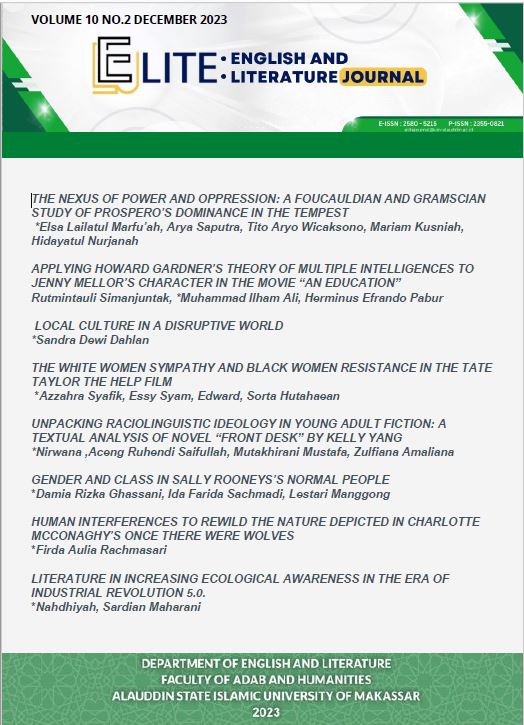HUMAN INTERFERENCES TO REWILD THE NATURE DEPICTED IN CHARLOTTE MCCONAGHY’S ONCE THERE WERE WOLVES
Abstract
Environmental problems have become a severe issue in recent decades. The world has started to change due to human activities that affect the natural environment. Deforestation, industrialization, burning fuels, human overpopulation, and many more have triggered climate change. In her novel, Once There Were Wolves, Charlotte McConaghy vividly describes such a condition. This novel exposes how the Scottish Highlands begins to ruin because of the overabundant population of deer. They eat the plant shoots, and that makes the plants die. Moreover, this research intends to investigate human interferences in saving damaged nature as depicted in the novel. This study is a literary criticism since it aims to analyze the object used. Furthermore, the Ecocriticism approach was employed to analyze humans' efforts to help nature return to its natural state. The research method involves a deep reading and understanding of Charlotte McConaghy’s Once There Were Wolves, with a focus on the humans’ effort to rewild nature. The result reveals the portrayal of humans’ actions to help nature back into its natural state by releasing wolves as the apex predator, keeping the forest and vegetation, and finding places to grow trees. Doing those actions helps the Scottish Land back naturally. The deer population decreases and the land becomes a beautiful place to go.
Downloads
References
Adek, M. (2022). Slowly but Surely: The Maternal Phase of Sylvia Plath in Her Late Poems. Elite: English and Literature Journal, 9(1), 1-13. DOI: https://doi.org/10.24252/elite.v9i1.28432
Bhushan, V. (2021). An Ecology and Ecocriticism in Amitav Ghosh's "The Hungry Tide ."The Creative Launcher, 5 (6), 134-136. https://doi.org/10.53032/TCL.2021.5.6.18
Bressler, C. E. (2011). Literary Criticism: An Introduction to Theory and Practice. Boston: Pearson Longman.
Broughton, R. K., Bullock, J. M., George, C., Hill, R. A., Hinsley, S. A., Maziarz, M., . . . Pywell, R. F. (2021). Long-term woodland restoration on lowland farmland through passive rewilding. PLoS ONE, 16(6), 1. https://doi.org/10.1371/journal.pone.0252466
Brown, C., Mcmorran, R., & Price, M. F. (2012). Rewilding – A New Paradigm for Nature Conservation in Scotland? Scottish Geographical Journal, 127(4), 288-289. DOI: 10.1080/14702541.2012.666261
Buell, L. (2005). The Future of Environmental Criticism: Environmental Crisis and Literary Imagination. New Jersey: Blackwell Publishing.
Bu¨hne, H. S., Pettorelli, N., & Hoffmann, M. (2022). The Policy Consequences of Defining Rewilding. Springer, 94. https://doi.org/10.1007/s13280-021-01560-8
Chairani, S. H., Mas’ulah, & Setyorini, A. (2019). Relationship Between Human and Animal in Kate DiCamillo’s the Magician’s Elephant. Teaching of English Language and Literature Journal, 7(2), 75-76. DOI: http://dx.doi.org/10.30651/tell.v7i2.3179
Corlett, R. T. (2016). The Role of Rewilding in Landscape Design for Conservation. Springer, 127-128. DOI https://doi.org/10.1007/s40823-016-0014-9
Crist, E., Kopnina, H., Cafaro, P., Gray, J., Ripple, W. J., Safina, C., . . . Piccolo, a. J. (2021). Protecting Half the Planet and Transforming Human Systems Are Complementary Goals. Perspective, 2, 1. doi:https://doi.org/10.3389/fcosc.2021.761292
Fard, S. F. (2016). A Short Introduction to Literary Criticism. International Journal of Humanities and Cultural Studies, 5(4), 330-332.
Garrard, G. (2004). Ecocriticism: The New Critical Idiom. New York: Routledge.
Giffen, R. A., Ryan, C. M., E. P., Pounch, M. A., & Brown, S. (2022). Storing More Carbon by Improving Forest Management in the Acadian Forest of New England, USA. Multidisciplinary Digital Publishing Institute, 13(12), 1. https://doi.org/10.3390/f13122031
Glotfelty & Fromm, C., & Fromm, H. (1996). The Ecocriticism Reader: Landmarks in Literary Theory. Athens: University of Georgia Press.
Helmer, W., Saavedra, D., Sylvén, M., Schepers, F. (Eds.) (2015). Rewilding Europe: A New Strategy for an Old Continent. Berlin: Springer, Cham.
Hove, G., Rathaha, T., & Mugiya, P. (2020). The Impact of Human Activities on the Environment, Case of Mhondongori in Zvishavane, Zimbabwe. Journal of Geoscience and Environment Protection Environment, Case of Mhondongori in Zvishavane, Zimbabwe, 8(10), 330-331. DOI: 10.4236/gep.2020.810021
Islam, M. R. (2018). An Ecocritical Perspective of Ruskin Bond’s “My Father’s Trees in Dehra” and “The Leopard”. The Achievers Journal, 4(2), 2.
McConaghy, C. (2021). Once There Were Wolves. New York: Flatiron Book.
Mukhtar, Rabia. An Overview of Ecocriticism. International Journal of English Language, Literature, and Translation Studies, 4(3), 315.
Muñoz, M. C., Valle, M., White, R. L., & Jaé, R. (2019). How Can We All Help Conserve Nature? Biodiversity, 7(84), 1-5. doi: 10.3389/frym.2019.00084
Nahdhiyah. (2018). The Relation Between Human, Universe, and God in Ahmad Fuadi's Novel Anak Rantau. Elite: English and Literature Journal, 5(1), 46-54. doi:https://doi.org/10.24252/elite.v5i1a5
Nsah, K. T. (2018). No Forest, No Water. No Forest, No Animals: An Ecocritical Reading of Ekpe Inyang’s The Hill Barbers. Ecozon, 9(1), 95-96. DOI: 10.37536/ECOZONA.2018.9.1.1581
Paradewari, D. S., Avillanova, A. A., & Lasar, A. B. (2018). Promoting Environmental Awareness in Learning Contexts. International Journal of Humanity Studies, 1(2), 243. doi:https://doi.org/10.24071/ijhs.v1i2.1322
Raynor, J. L., Grainger, C. A., & Parker, D. P. (2021). Wolves make roadways safer, generating large economic returns to predator conservation. The Proceedings of the National Academy of Sciences, 118(22), 1-5. https://doi.org/10.1073/pnas.2023251118
Copyright (c) 2023 Firda Aulia Rachmasari, Muhammad Edy Thoyib

This work is licensed under a Creative Commons Attribution-NonCommercial-ShareAlike 4.0 International License.
Once an article was published in the journal, the author(s) are:
granted to the journal right licensed under Creative Commons License Attribution that allows others to share the work with an acknowledgement of the work's authorship.
permitted to publish their work online in third parties as it can lead wider dissemination of the work.
continue to be the copyright owner and allow the journal to publish the article with the CC BY-NC-SA 4.0 license
receiving a DOI (Digital Object Identifier) of the work.


